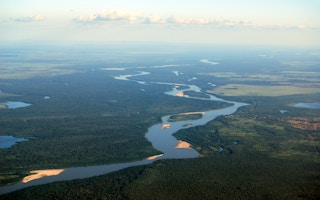Brazil’s success in slowing rain forest destruction has resulted in enormous reductions in carbon emissions and shows that it’s possible to zealously promote sustainability while still growing the economy, suggests a new study out Thursday.
A second study out this week also underscores Brazil’s success and shows that deforestation has also slowed in several other tropical countries.
Since 2004, farmers and ranchers in Brazil have saved over 33,000 square miles (86,000 square kilometers) of rain forest from clear-cutting, the rough equivalent of 14.3 million soccer fields, a team of scientists and economists from the US and South America report in Science. At the same time, production of beef and soy from Brazil’s Amazon region rose.
The country has reduced deforestation by 70 per cent and kept 3.2 billion tons of carbon dioxide out of the atmosphere, because forests use carbon as they grow and release it when they are removed, often through burning. That makes Brazil’s the biggest reduction in greenhouse gas emissions of any country in the world; the cut is more than three times bigger than the effect of taking all the cars in the US off the road for a year.
“Brazil is known as a leading favorite to win the World Cup, but they also lead the world in mitigating climate change,” the Science study’s lead author, Daniel Nepstad of the Earth Innovation Institute in San Francisco, said in a statement.
Brazil’s success in saving about 80 per cent of the original Amazon serves as a model for other countries around the world and represents a “completely different trajectory for forest areas over the last few centuries,” says Toby McGrath, a senior scientist at the institute and another of the study’s co-authors. (See “Photos: The Last of the Amazon.”)
“For the first time in history, we are stopping the process of forest loss on a frontier before it gets seriously depleted, while continuing to develop economies that still have substantial forest cover,” says McGrath.
Globally, deforestation is responsible for about 10 per cent of all climate emissions, says a study released Wednesday by the Union of Concerned Scientists. That’s down from 17 per cent of emissions in the 1990s, thanks to falling rates of deforestation.
“Brazil is most notably lauded for their deforestation reductions, but the report found numerous example of successfully saving forests in unexpected locations,” study author Doug Boucher, director of the Union of Concerned Scientists’ Tropical Forest and Climate Initiative, said in a statement. Mexico, El Salvador, and six countries in Central Africa, in particular, have shown decreased rates of deforestation.
“
One important element was the advancement of remote sensing technology. Although Brazil first passed a forest code requiring landowners in the Amazon to protect at least 50 per cent of native forest in 1965, enforcement was spotty
Measure of success
For the Science study, scientists and economists analyzed how Brazil was able to reverse decades of high rates of deforestation in the Amazon, starting in 2005, when then-president Luiz Inácio Lula da Silva announced the ambitious goal of slashing the rate by 80 percent over the previous year. After that, things turned around due to a number of factors coming together, says McGrath.
One important element was the advancement of remote sensing technology. Although Brazil first passed a forest code requiring landowners in the Amazon to protect at least 50 per cent of native forest in 1965, enforcement was spotty. “Officials didn’t have good information on where deforestation was occurring and who was on the ground,” says McGrath.
Over the past few years, satellites have given officials a more precise picture of the forest, often in real time.
Another boost to deforestation efforts: The forest code was updated in 2012 and now requires landowners to preserve 80 per cent of the Amazon’s virgin forest, as well as protect watersheds. Those that have violated the rules have increasingly received fines and even jail time in extreme cases.
Nonprofit groups, meanwhile, have helped publicize data on rule breakers and have built support for enforcing the law. Campaigns by Greenpeace, Conservation International, and others put pressure on companies that buy products from the Amazon, especially beef and soy, shaming those that have been found to contribute to deforestation. Market agreements signed by companies took that a step further, prohibiting practices that lead to deforestation.
“In Brazil, there was rising awareness of the value of nature and how essential it is to our society,” says Fabio Rubio Scarano, the vice president of Conservation International‘s Americas Division, who is based in Rio de Janeiro.
In a tough regulatory approach called “critical counties,” the Brazilian government also removes incentives for all the agricultural producers in a county if there’s a lot of deforestation going on there. There has been rising opposition to this program, but it has been effective, says McGrath. “It increases internal pressure to make everybody fall in line.”
The Brazilian government has also created new protected reserves of forest in the Amazon, especially along frontier areas where deforestation had started. Managing these new areas has effectively stopped its tree loss, says McGrath.
Read the full story at National Geographic here.










